The Influence of Seasonality on the Multi-Spectral Image Segmentation for Identification of Abandoned Land
Abstract
1. Introduction
- Spectral Angle Mapping (SAM);
- Maximum_Likelihood (ML);
- Minimum distance (MD).
2. Materials and Methods
2.1. Study Area
2.2. Study Data
- The multi-spectral Sentinel-2 images:
- 23 April 2019;
- 8 July 2019;
- 10 September 2019.
- 2.
- The abandoned land layer was obtained from the open database from the Spatial Information portal in Lithuania [7]. The data are regularly updated.
2.3. Image Segmentation Methods
2.3.1. Spectral Angle Mapper (SAM)
- The Optimal Spectral Library (OSL) was generated, which preserved the spectral variability present within each ROI. This library could be considered as “optimal” since it contained the spectra that classified all pixels of a certain class correctly, without misclassifying pixels that did not belong to that class. At the same time, for each reference spectrum, a maximum spectral angle distance was calculated, which was used in the second step to avoid misclassifications;
- All image pixels were classified using the reference spectra stored in the OSL, taking into account the calculated maximum spectral angle distance. This meant that each pixel was assigned to the class of the reference spectrum for which the smallest spectral angle value was calculated with the actual pixel spectrum.
2.3.2. Maximum_Likelihood Image Segmentation Method (ML)
- The number of land cover types within the study area is determined;
- The training (ROI) pixels for each of the desired classes are chosen using land cover information for the study area. For this purpose, the Jeffries–Matusita (JM) distance can be used to measure the class separability of the chosen training pixels (ROI) [11,12]. The JM distance is a parametric criterion, for which the values range between 0 and 2. The JM considers the distance between the class means and distribution of values from the means. This is achieved by involving the covariance matrices of the classes in the separability measurement [11]. Scientists J. Xie and H.T. Tsui noted that this method can guarantee a good match of the model with the image and avoid assigning high class uncertainties to only these pixels on the ‘‘strongest’’ edges [19]. In the case of the ML per-pixel algorithm, the class to which the pixel is finally assigned is the one with the highest probability. Probabilities of class membership, on which the assignment is based, are usually disregarded so that after classification, no information on the probabilities is available. To overcome the limitations of the classical techniques, such as maximum likelihood classification per-pixel, the “images” are mapped into the likelihood of class labels per sample under the assumption of equal prior probabilities. It is assumed that the normal distribution function will approximate the frequency distributions associated with each of the classes [12]. The maximum probability calculation algorithms described in the Abkar and Sharifi article were also used.
2.3.3. Minimum Distance Segmentation of Image Algorithm
3. Result of Segmentation
3.1. Segmentation Results of April
3.2. Segmentation Results of July
3.3. Segmentation Results of September
3.4. Segmentation Results Analysis
4. Conclusions and Discussion
5. Recommendation
Author Contributions
Funding
Institutional Review Board Statement
Informed Consent Statement
Data Availability Statement
Acknowledgments
Conflicts of Interest
References
- Karila, K.; Matikainen, L.; Litkey, P.; Hyyppa, J.; Puttonen, E. The effect of seasonal variation on automated land cover mapping from multispectral airborne laser scanning data. Int. J. Remote Sens. 2018, 40. [Google Scholar] [CrossRef]
- Sheeren, D.; Fauvel, O.M.; Josipović, V.; Lopes, M.; Planque, C.; Willm, J.; Dejoux, J.F. Tree Species Classification in Temperate Forests Using Formosat-2 Satellite Image Time Series. Remote Sens. 2016, 8, 734. [Google Scholar] [CrossRef]
- Sužiedelytė Visockienė, J.; Tumelienė, E.; Malienė, V. Identification of Heracleum sosnowskyi-invaded land using earth remote sensing data. Sustainability 2020, 12, 759, ISSN 2071-1050. [Google Scholar] [CrossRef]
- Song, W. Mapping Cropland Abandonment in Mountainous Areas Using an Annual Land-Use Trajectory Approach. Sustainability 2019, 11, 5951. [Google Scholar] [CrossRef]
- Order of the Government of the Republic of Lithuania. On Establishment of Lithuanian Geodetic Coordinate System; Dėl Lietuvos Geodezinių Koordinačių Sistemos Įvedimo; No. 936; Lietuvos Respublikos Vyriausybės Nutarimas: Vilnius, Lithuania, 1994. (In Lithuanian) [Google Scholar]
- Radiometric Resolutions. 2021. Available online: https://sentinels.copernicus.eu/web/sentinel/user-guides/sentinel-2-msi/resolutions/radiometric (accessed on 2 April 2021).
- Spatial Information Portal of Lithuania. 2021. Available online: www.geoportal.lt (accessed on 2 April 2021).
- Unsalan and Boyer. Multispectral Satellite Image Understanding. 2011. Available online: https://www.researchgate.net/publication/321515169 (accessed on 25 April 2021). [CrossRef][Green Version]
- Rosenberger, C.; Chabrier, S.; Laurent, H.; Emile, B. Unsupervised and Supervised Image Segmentation Evaluation. 2006. Available online: https://www.researchgate.net/publication/257365161 (accessed on 5 May 2021). [CrossRef][Green Version]
- Bertels, L.; Deronde, B.; Kempeneers, P.; Debruyn, W.; Provoost, S. Optimized Spectral Angle Mapper classification of spatially heterogeneous dynamic dune vegetation, a case study along the Belgian coastline. In Proceedings of the 9th International Symposium on Physical Measurements and Signatures in Remote Sensing (ISPMSRS), Beijing, China, 17–19 October 2005. [Google Scholar]
- Dobbor, M.; Hower, S.; Shokr, M.; Yackel, J.J. Howell the Jeffries–Matusita distance for the case of complex Wishart distribution as a separability criterion for fully polarimetric SAR data. Int. J. Remote Sens. 2014, 35, 6859–6873. [Google Scholar]
- Abkar, A.A.; Sharifi, M.A. Likelihood-Based Image Segmentation and Classification: Concepts and Applications. In Proceedings of the ISPRS 2000 Congress: Geoinformation for All, Amsterdam, The Netherlands, 16–23 July 2000; Volume XXXIII, pp. 9–16. [Google Scholar]
- Low, F.; Fliemann, E.; Abdullaev, I.; Conrad, C.; Lamers, J.P.A. Mapping abandoned agricultural land in Kyzyl-Orda, Kazakhstan using satellite remote sensing. Appl. Geogr. 2015, 62, 377–390. [Google Scholar] [CrossRef]
- National Land Service under the Ministry of Agriculture. Reports of State Land Fund. 2005–2021; National Land Service under the Ministry of Agriculture: Vilnius, Lithuania, 2005–2021. [Google Scholar]
- Land Information System. Available online: https://zis.lt/ (accessed on 3 June 2021).
- Congedo, L. Semi-Automatic Classification Plugin for QGIS; Project Title: Adapting to Climate Change in Coastal Dar es Salaam, Ref. EC Grant Contract No. 2013. 2010/254-773; Sapienza University of Rome: Rome, Italy, 2013. [Google Scholar]
- Kruse, F.A.; Lefkoff, A.B.; Boardman, J.W.; Heidebrecht, K.B.; Shapiro, A.T.; Barloon, P.J.; Goetz, A.F.H. The spectral image processing system (SIPS)—interactive visualization and analysis of imaging spectrometer data. Remote Sens. Environ. 1993, 44, 145–163. [Google Scholar] [CrossRef]
- Ahmad, A. Analysis of maximum likelihood classification on multispectral data. Appl. Mathemat. Sci. 2012, 6, 6425–6436. [Google Scholar]
- Xie, J.; Tsui, H.T. Image segmentation based on maximum-likelihood estimation and optimum entropy-distribution (MLE–OED). Pattern Recognit. Lett. 2004, 25, 1133–1141. [Google Scholar] [CrossRef]
- Richards, J.A.; Jia, X. Remote Sensing Digital Image Analysis. An Introduction; Springer: Berlin/Heidelberg, Germany, 2006; Available online: https://www.springer.com/gp/book/9783642300615#otherversion=9783642300622 (accessed on 5 May 2021).
- GIS Geography, Spectral Signature. 2021. Available online: https://gisgeography.com/spectral-signature/ (accessed on 7 April 2021).
- Silveira, E.M.O.; Bueno, I.T.; Acerbi-Junior, F.W.; Mello, J.M.; Scolforo, J.R.S.; Wulder, M.A. Using Spatial Features to Reduce the Impact of Seasonality for Detecting Tropical Forest Changes from Landsat Time Series. Remote Sens. 2018, 10, 808. [Google Scholar] [CrossRef]
- Lu, M.; Chen, J.; Tang, H.; Rao, Y.; Yang, P.; Wu, W. Land cover change detection by integrating object-based data blending model of Landsat and MODIS. Remote Sens. Environ. 2016, 184, 374–386. [Google Scholar] [CrossRef]
- Wang, X.; Li, Z.; Zhou, X.; Tao, J. Segmentation model for hyperspectral remote sensing images based on spectral angle constrained active contour. Multimed. Tools Appl. 2019, 78, 10141–10155. [Google Scholar] [CrossRef]
- Cohen, J. A Coefficient of Agreement for Nominal Scales. Educ. Psychol. Meas. 1960, 20, 37–46. [Google Scholar] [CrossRef]
- Foody, G.M. Explaining the unsuitability of the kappa coefficient in the assessment and comparison of the accuracy of thematic maps obtained by image classification. Remote Sens. Environ. 2020, 239, 111630. [Google Scholar] [CrossRef]
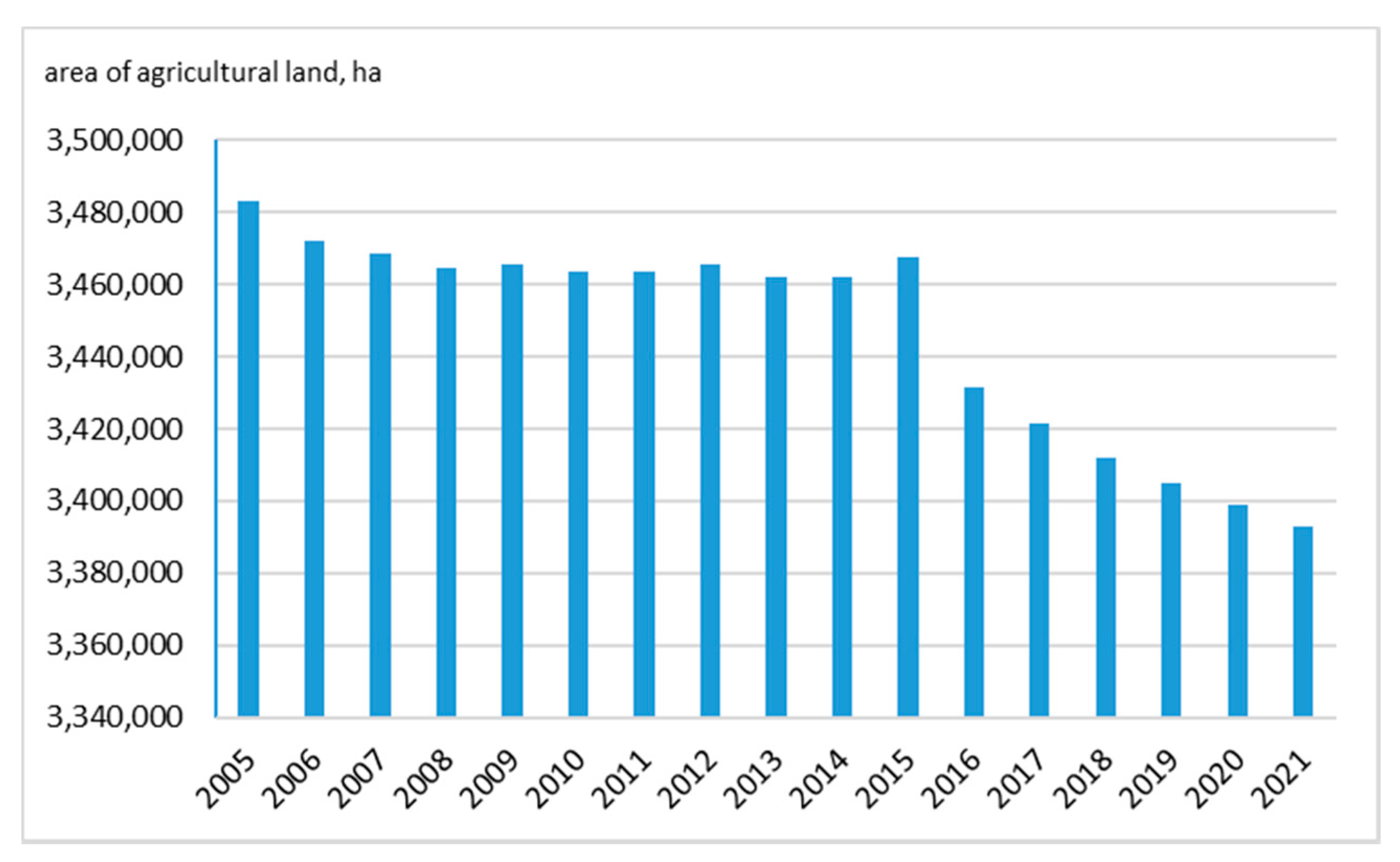
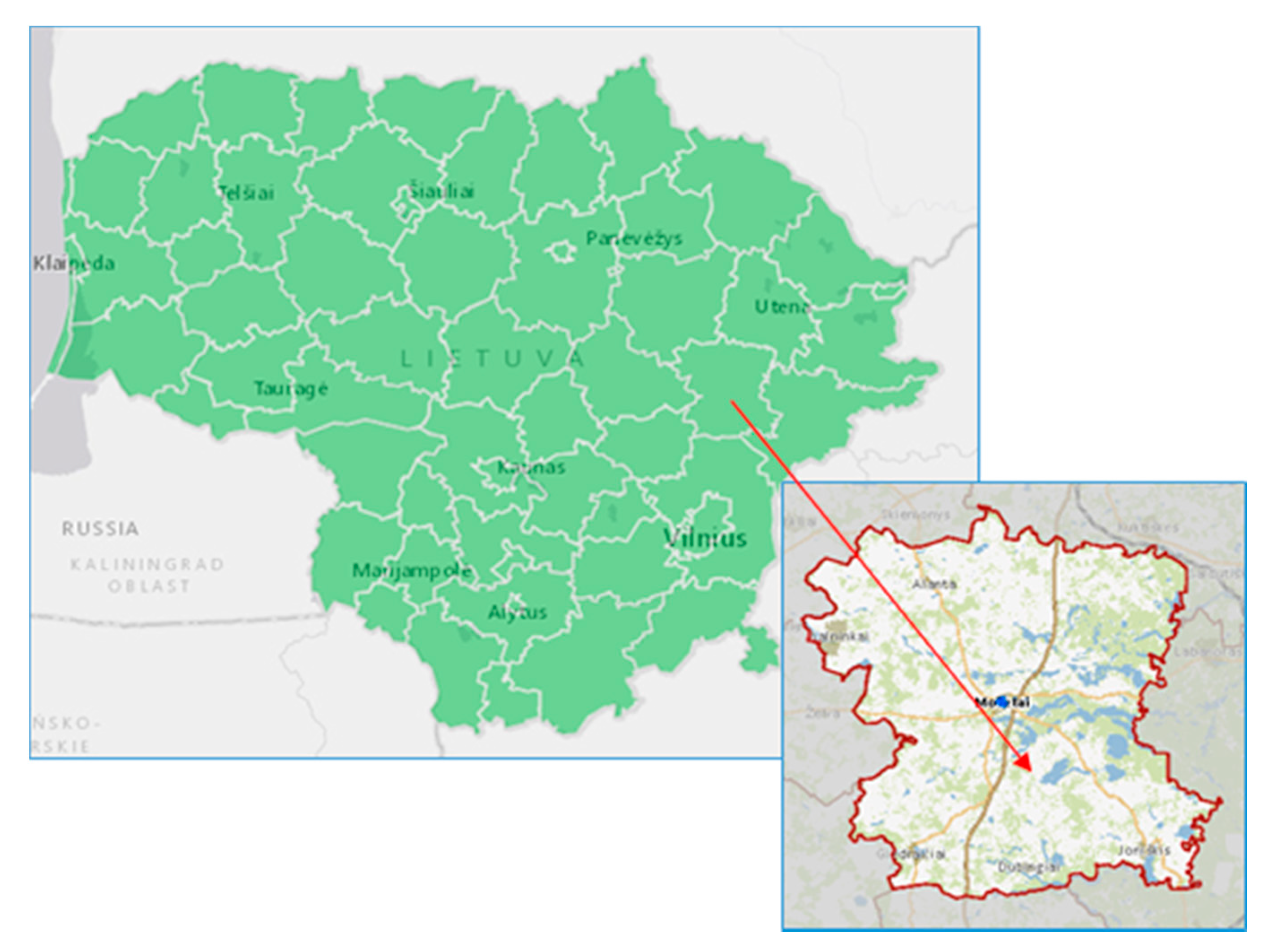

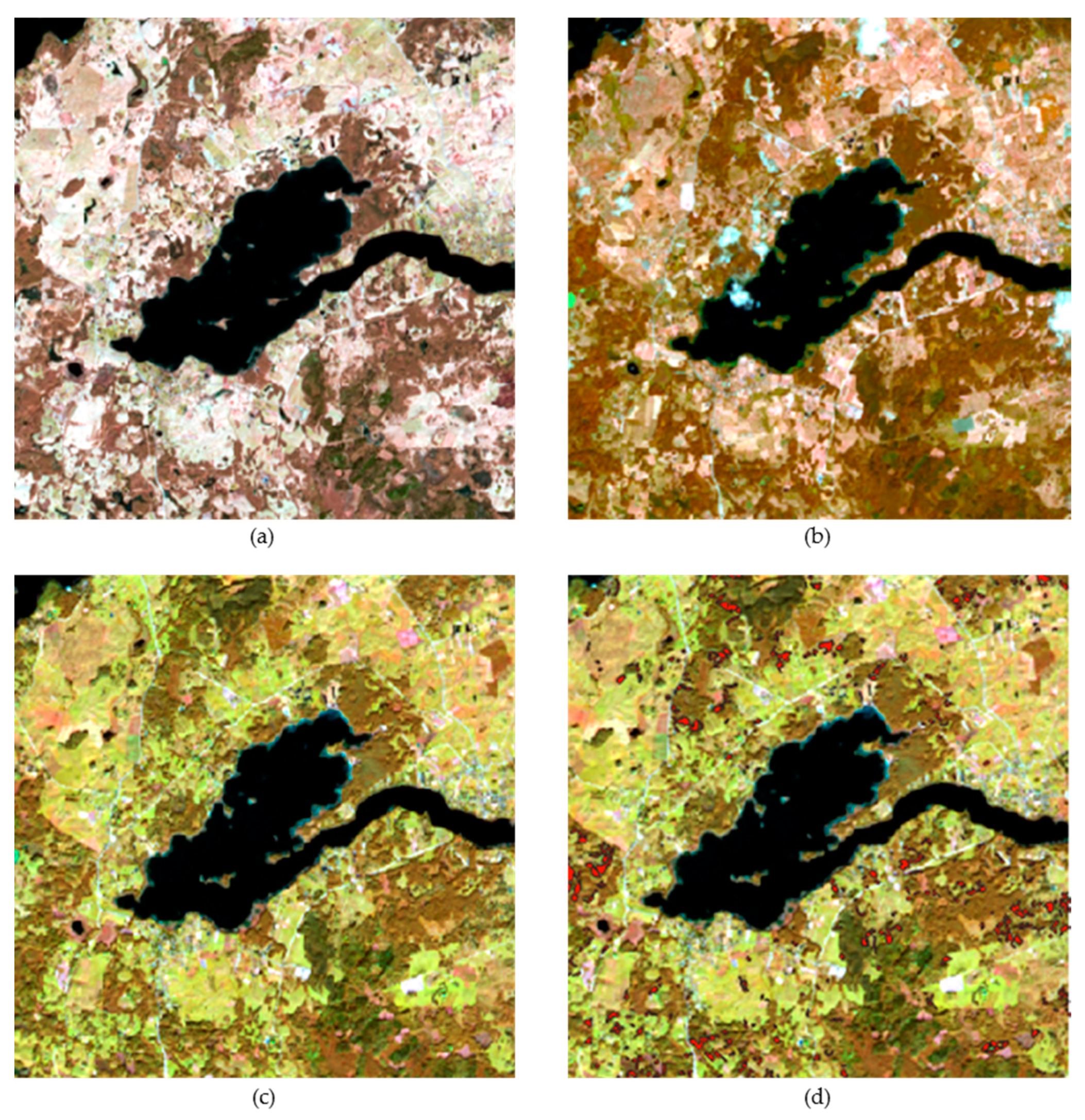

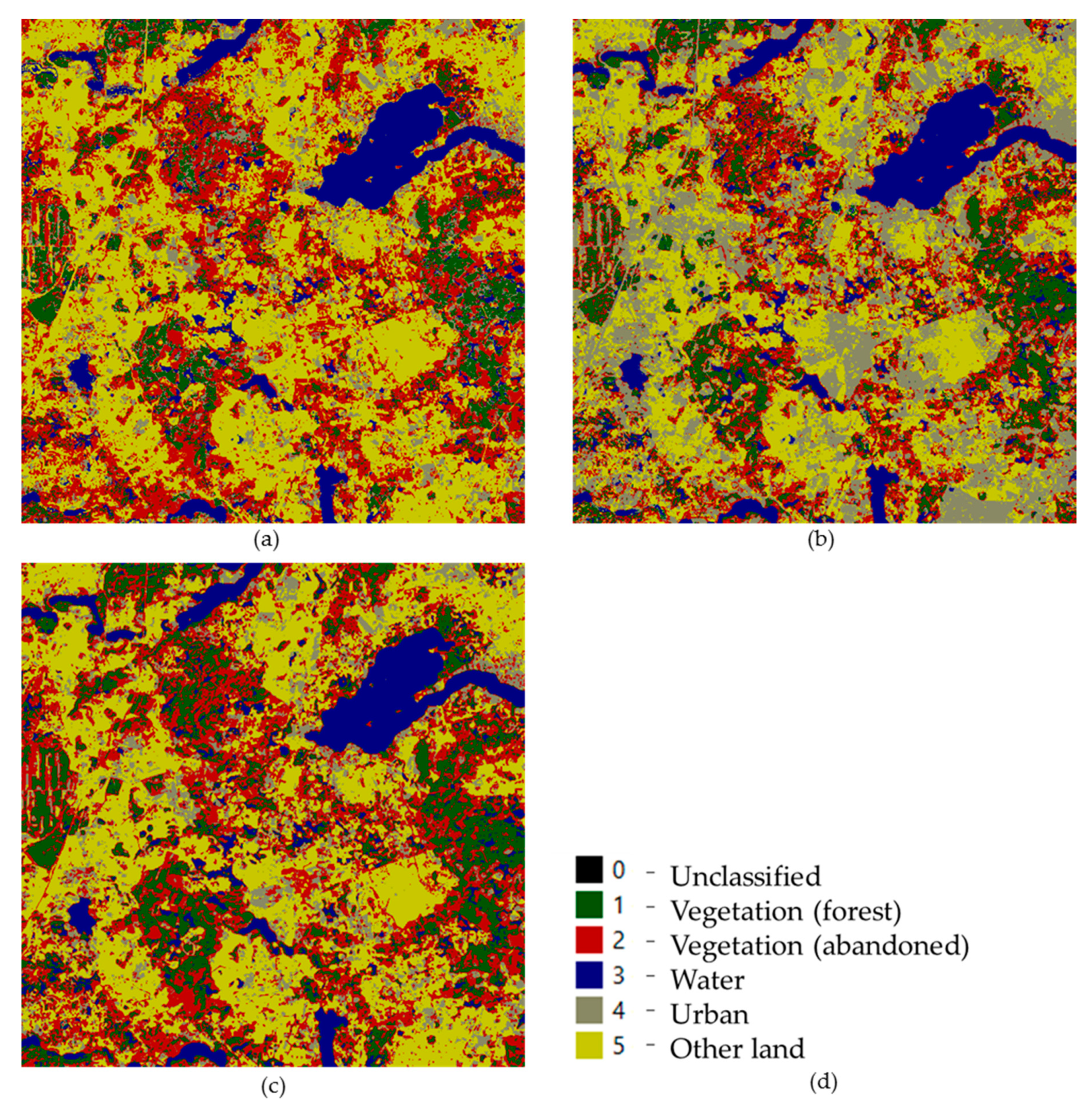


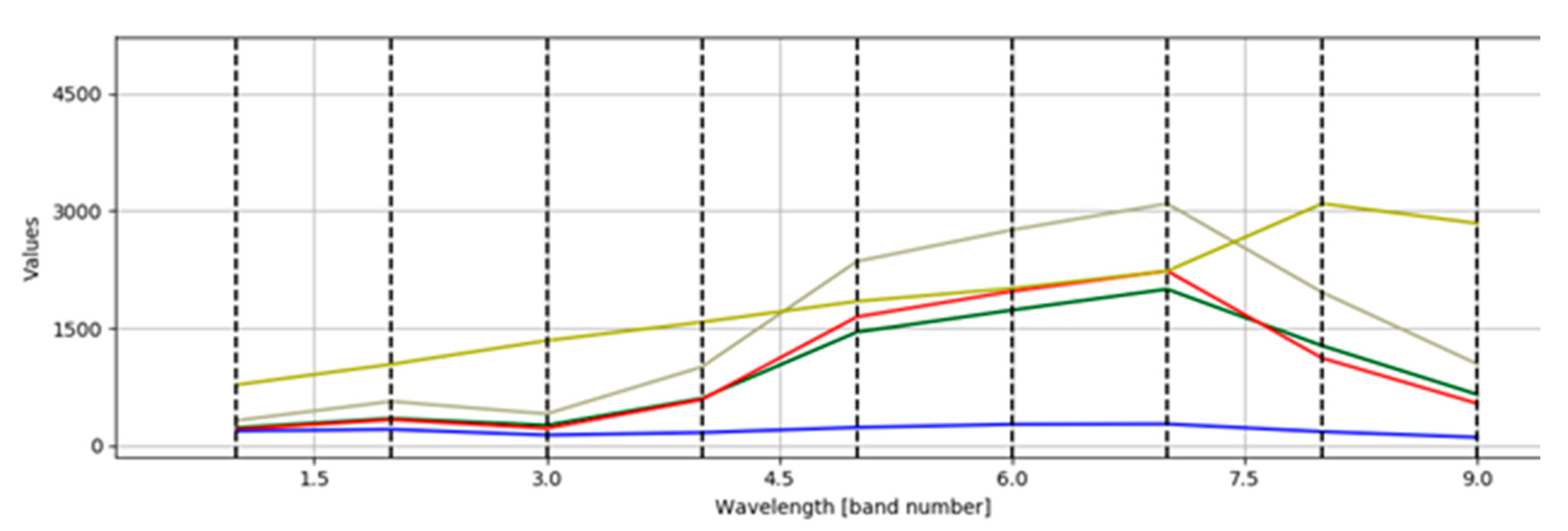
| Band Number | S2A | S2B | Lref (Reference Radiance) (W m−2 sr−1 mm−1) | SNR @ Lref | ||
|---|---|---|---|---|---|---|
| Central Wavelength (nm) | Bandwidth (nm) | Central Wavelength (nm) | Bandwidth (nm) | |||
| 2 | 492.4 | 66 | 492.1 | 66 | 128 | 154 |
| 3 | 559.8 | 36 | 559.0 | 36 | 128 | 168 |
| 4 | 664.6 | 31 | 664.9 | 31 | 108 | 142 |
| 8 | 832.8 | 106 | 832.9 | 106 | 103 | 174 |
| April | |||||||||||||
|---|---|---|---|---|---|---|---|---|---|---|---|---|---|
| Classes | Colour | Spectral Angle Mapping | Maximum Likelihood | Minimum Distance | |||||||||
| Area, % | Spectral Signature | Area, % | Spectral Signature | Area, % | Spectral Signature | ||||||||
| B3 | B4 | B8 | B3 | B4 | B8 | B3 | B4 | B8 | |||||
| Vegetation (forest) |  | 9.62 | 467 | 724 | 1593 | 11.80 | 443 | 712 | 1593 | 16.28 | 467 | 728 | 1593 |
| Vegetation (abandoned) |  | 29.92 | 823 | 1119 | 2452 | 21.08 | 699 | 995 | 2211 | 29.44 | 823 | 1119 | 2452 |
| Water |  | 9.04 | 214 | 267 | 460 | 9.13 | 214 | 267 | 460 | 9.14 | 214 | 267 | 460 |
| Urban |  | 9.76 | 1139 | 1559 | 3005 | 27.84 | 1192 | 1548 | 3017 | 11.87 | 1139 | 1559 | 3005 |
| Other land |  | 41.66 | 1169 | 1552 | 3567 | 30.14 | 1454 | 1786 | 3434 | 33.26 | 1552 | 1894 | 3567 |
| Classes | April | |||||
|---|---|---|---|---|---|---|
| SAM | ML | MD | ||||
| θ | S, % | θ | S, % | θ | S, % | |
| Forest–Vegetation (abandoned) | 5.69 | 81 | 5.61 | 85 | 5.69 | 81 |
| Vegetation (abandoned)–Water | 9.63 | 36 | 10.12 | 39 | 9.63 | 36 |
| Vegetation (abandoned)–Urban | 4.50 | 84 | 3.33 | 80 | 4.50 | 84 |
| Vegetation (abandoned)–Other land | 3.95 | 78 | 4.63 | 75 | 3.95 | 78 |
| July | |||||||||||||
|---|---|---|---|---|---|---|---|---|---|---|---|---|---|
| Classes | Colour | Spectral Angle Mapping | Maximum Likelihood | Minimum Distance | |||||||||
| Area, % | Spectral Signature | Area, % | Spectral Signature | Area, % | Spectral Signature | ||||||||
| B3 | B4 | B8 | B3 | B4 | B8 | B3 | B4 | B8 | |||||
| Vegetation (forest) |  | 34.31 | 275 | 789 | 1768 | 0.76 | 295 | 632 | 1003 | 1.00 | 324 | 647 | 984 |
| Vegetation (abandoned) |  | 10.48 | 950 | 1460 | 2860 | 1.05 | 318 | 709 | 1315 | 9.82 | 302 | 738 | 1553 |
| Water |  | 5.14 | 214 | 246 | 222 | 4.98 | 211 | 245 | 222 | 5.14 | 214 | 246 | 222 |
| Urban |  | 47.58 | 669 | 1241 | 2541 | 92.95 | 602 | 1145 | 2343 | 79.19 | 561 | 1120 | 2357 |
| Other land |  | 2.5 | 2235 | 2669 | 3746 | 0.26 | 1480 | 1874 | 3488 | 4.82 | 1891 | 2369 | 3693 |
| Classes | July | |||||
|---|---|---|---|---|---|---|
| SAM | ML | MD | ||||
| θ | S, % | θ | S, % | θ | S, % | |
| Forest–Vegetation (abandoned) | 20.12 | 80 | 2.73 | 89 | 6.81 | 78 |
| Vegetation (abandoned)–Water | 26.02 | 25 | - | 37 | 32.74 | 32 |
| Vegetation (abandoned)–Urban | 7.58 | 92 | 4.89 | 78 | 6.51 | 86 |
| Vegetation (abandoned)–Other land | 12.36 | 78 | 24.82 | 69 | 24.84 | 67 |
| Forest–Urban land | 5.69 | 68 | 5.94 | 67 | ||
| September | |||||||||||||
|---|---|---|---|---|---|---|---|---|---|---|---|---|---|
| Classes | Colour | Spectral Angle Mapping | Maximum Likelihood | Minimum Distance | |||||||||
| Area, % | Spectral Signature | Area, % | Spectral Signature | Area, % | Spectral Signature | ||||||||
| B3 | B4 | B8 | B3 | B4 | B8 | B3 | B4 | B8 | |||||
| Vegetation (forest) |  | 48.30 | 261 | 730 | 1462 | 8.41 | 259 | 604 | 1276 | 14.15 | 233 | 569 | 1169 |
| Vegetation (abandoned) |  | 5.20 | 599 | 1053 | 2148 | 7.14 | 219 | 587 | 1118 | 35.77 | 321 | 790 | 1612 |
| Water |  | 6.08 | 134 | 166 | 176 | 6.03 | 134 | 166 | 177 | 6.23 | 133 | 166 | 178 |
| Urban |  | 39.27 | 472 | 1164 | 2230 | 78.23 | 4005 | 1004 | 1959 | 43.44 | 466 | 1175 | 2232 |
| Other land |  | 1.13 | 1211 | 1454 | 2757 | 0.17 | 1342 | 1579 | 3098 | 0.41 | 1462 | 1729 | 3227 |
| Classes | September | |||||
|---|---|---|---|---|---|---|
| SAM | ML | MD | ||||
| θ | S, % | θ | S, % | θ | S, % | |
| Forest–Vegetation (abandoned) | 14.00 | 87 | 5.57 | 94 | 0.58 | 84 |
| Vegetation (abandoned)–Water | 22.00 | 24 | 25.80 | 33 | 24.43 | 26 |
| Vegetation (abandoned)–Urban | 23.32 | 21 | 5.3 | 79 | 2.81 | 85 |
| Vegetation (abandoned)–Other land | 25.85 | 20.5 | 32.62 | 69 | 28.34 | 74 |
Publisher’s Note: MDPI stays neutral with regard to jurisdictional claims in published maps and institutional affiliations. |
© 2021 by the authors. Licensee MDPI, Basel, Switzerland. This article is an open access article distributed under the terms and conditions of the Creative Commons Attribution (CC BY) license (https://creativecommons.org/licenses/by/4.0/).
Share and Cite
Tumelienė, E.; Visockienė, J.S.; Malienė, V. The Influence of Seasonality on the Multi-Spectral Image Segmentation for Identification of Abandoned Land. Sustainability 2021, 13, 6941. https://doi.org/10.3390/su13126941
Tumelienė E, Visockienė JS, Malienė V. The Influence of Seasonality on the Multi-Spectral Image Segmentation for Identification of Abandoned Land. Sustainability. 2021; 13(12):6941. https://doi.org/10.3390/su13126941
Chicago/Turabian StyleTumelienė, Eglė, Jūratė Sužiedelytė Visockienė, and Vida Malienė. 2021. "The Influence of Seasonality on the Multi-Spectral Image Segmentation for Identification of Abandoned Land" Sustainability 13, no. 12: 6941. https://doi.org/10.3390/su13126941
APA StyleTumelienė, E., Visockienė, J. S., & Malienė, V. (2021). The Influence of Seasonality on the Multi-Spectral Image Segmentation for Identification of Abandoned Land. Sustainability, 13(12), 6941. https://doi.org/10.3390/su13126941








